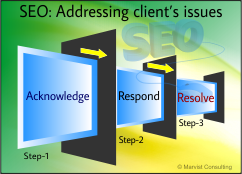Business relationship like all other relationships is fragile at the start. It needs commitment to work on a new business relationship and build a good rapport with the client. Regular communication and showing courtesy are important in order to build a good rapport. However, without resolution, all communication despite courtesy and pleasantness is useless and the relationship may not last long. If we are not able to deliver the goods or not able to resolve a particular issue, it shows incompetence. So, it’s the responsibility of the client servicing person to coordinate with the appropriate SEO Specialists in a better manner to get an issue resolved.
Professional client servicing person can adapt the following 3-step approach to address and resolve client’s queries in a better way:
1. Time to Acknowledge:
 Whenever there is a message from the client to get the issues resolved, the first thing client would be more interested is to know if someone has confirmed the receipt of the message, instead of expecting resolution. So, it is the job of client servicing person to first confirm that the message is received.
Whenever there is a message from the client to get the issues resolved, the first thing client would be more interested is to know if someone has confirmed the receipt of the message, instead of expecting resolution. So, it is the job of client servicing person to first confirm that the message is received.
The amount of time it takes for the client servicing person to confirm the receipt of message is Time to Acknowledge and this shouldn’t take much time.
Typically, many service providers try to get resolution, without feeling the need for the acknowledgement, irrespective of the nature of the issue. This in many situations is counterproductive. Some issues need time, before they are resolved.
Though the client servicing folks are generally experienced and broadly knowledgeable, they are not experts in the subject matter. Their primary responsibility is to coordinate with the appropriate SEO specialists and allow them to do their job in getting the appropriate resolution in place. This entire process is time consuming. Hence, it is very important to acknowledge the client – to give an impression that the client servicing person is on the job.
2. Time to respond:
Once the client servicing person acknowledges, the next step is to get back with a game plan and time frame for resolution. The duration between time to acknowledge and the time to get back with the game plan is the Time to respond.
Time to respond helps to:
- Set the right expectations with the client
- Evaluate what it takes to best address the situation
- Provide adequate time so that the experts can properly address the situation.
- Come up with a resolution plan
During this time, the client servicing person will schedule this activity by assigning it to the appropriate specialists and later prioritizes the specialists and follows up with them to come up with a game plan as to how many hours it would take to solve the issue.
While the client servicing person may not always have answers to clients’ queries or control over the resolution of a particular issue, one thing the client servicing person can be 100% responsible is time to acknowledge and time to respond by asking the team members to provide a realistic and reasonable time frame by when the issue will be resolved.
3. Time to resolve:
Once the resolution plan is shared, the time it takes to actually resolve the issue is Time to resolve. How long it would take to resolve the problem determines the client servicing person’s professionalism, competence and commitment towards the client.
Whenever the client servicing person feels the ‘time to resolve’ is in risk of being delayed, it is the client servicing person’s responsibility on behalf of the client to make sure the organization commits / prioritizes the resources to actually execute on this commitment.
While time to acknowledge, time to respond and time to resolve are three elements of a typical three step approach in addressing the client’s issues. Nevertheless, at times, the entire process can be either finished in one step or in two steps, making it thus possible to not necessarily go through the procedure in 3 separate transactions or events, while ensuring achievement of the purpose.
Thus, following this framework, it is beneficial to both client and the service provider as it provides a more professional approach to address issues of the client’s project.
